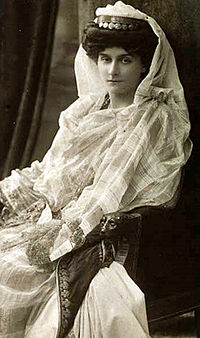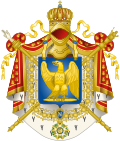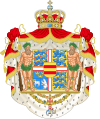- Princess Marie Bonaparte
-
Princess Marie Bonaparte Princess George of Greece and Denmark 
Spouse Prince George of Greece and Denmark Issue Prince Peter
Princess EugénieHouse House of Bonaparte
House of Schleswig-Holstein-Sonderburg-GlücksburgFather Roland Bonaparte Mother Marie-Félix Blanc Born 2 July 1882
Saint-Cloud, FranceDied 21 September 1962 (aged 80)
Saint-Tropez, FranceBurial Royal Cemetery, Tatoi Palace, Greece Princess Marie Bonaparte (2 July 1882 – 21 September 1962) was a French author and psychoanalyst, closely linked with Sigmund Freud. Her wealth contributed to the popularity of psychoanalysis, and enabled Freud's escape from Nazi Germany.
Marie Bonaparte was a great-grandniece of Emperor Napoleon I of France. She was a daughter of Prince Roland Bonaparte (19 May 1858–14 April 1924) and Marie-Félix Blanc (1859–1882). Her paternal grandfather was Pierre Napoleon Bonaparte, son of Lucien Bonaparte, who was one of Napoleon's rebellious and disinherited younger brothers. For this reason, despite her title Marie was not a member of the dynastic branch of the Bonapartes who claimed the French imperial throne from exile. However, her maternal grandfather was François Blanc, the principal real-estate developer of Monte Carlo. It was from this side of her family that Marie inherited her great fortune.
Contents
Early life
She was born at Saint-Cloud, a town in Hauts-de-Seine, Île-de-France. Her mother died of an embolism induced when giving birth to Marie.
On 21 November 1907 in Paris, she married Prince George of Greece and Denmark, the second son of King George I of the Hellenes, in a civil ceremony, with a subsequent religious ceremony on 12 December 1907, at Athens. She was thereafter officially also known as Princess George of Greece and Denmark. They had two children, Peter (1908–1980) and Eugénie (1910–1989).
Sexual research
Troubled by her difficulty in achieving sexual fulfillment, Marie engaged in research. In 1924 she published her results under the pseudonym A. E. Narjani and presented her theory of frigidity in the medical journal Bruxelles-Médical. Having measured the distance between the clitoris and the vagina in 243 women, she concluded after analysing their sexual history that the distance between these two organs was critical for the ability to reach orgasm ("volupté"); she identified women with a short distance (the "paraclitoridiennes") who reached orgasm easily during intercourse, and women with a distance of more than two and a half centimeters (the "téleclitoridiennes") who had difficulties while the "mesoclitoriennes" were in between.[1] Marie considered herself a "téleclitorienne" and approached Josef Halban to surgically move her clitoris closer to the vagina. She underwent and published the procedure as the Halban-Narjani operation.[1] When it proved unsuccessful in facilitating the sought-after outcome for Marie, the physician repeated the operation.
She modeled for the Romanian modernist sculptor Constantin Brâncuşi. His sculpture of her, "Princess X," [1] created a scandal in 1919 when he represented her or caricatured her as a large gleaming bronze phallus. This phallus symbolizes the model's obsession with the penis and her lifelong quest to achieve vaginal orgasm. Sigmund Freud, the father of psychoanalysis, condemned orgasm by clitoral stimulation and praised vaginal orgasm with a penis as the superior and only legitimate type. His condemnation echoed the social mores of his era which condemned masturbation as both morally harmful and as a cause of mental disorders.
Freud
In 1925 Marie consulted Freud for treatment of what she described as her frigidity, which was later explained as a failure to have orgasms during missionary position intercourse.[2] It was to Marie Bonaparte that Sigmund Freud remarked, "The great question that has never been answered and which I have not yet been able to answer, despite my thirty years of research into the feminine soul, is ‘What does a woman want?’". She later paid Freud's ransom to Nazi Germany, and preserved Freud's letters to Wilhelm Fliess despite Freud's wish that they be destroyed. Jacques Lacan, in his seminar 1960-61, "L'Angoisse", gave a particular lesson later named in Seuil' s Edition by Jacques-Alain Miller "Woman, more true and more real", in which he paints women as being "deuterophallic". He explains that by this he means the very simple fact that, if women are interested in phallic signifiers, paraphernalia or whatever, it is only as a means to reach men's desire, and in the strict function as this desire touches them.
Despite what she described as sexual dysfunction, she conducted affairs with Freud's disciple Rudolph Loewenstein, and Aristide Briand, the French prime minister.
Later life
On 2 June 1953, Marie and her husband represented their nephew, King Paul of Greece, at the coronation of Elizabeth II of the United Kingdom in London. Bored with the pageantry, Marie offered psychoanalysis to the gentleman seated next to her, who was the future French president François Mitterrand. Mitterrand obliged Marie, and the couple barely witnessed the pomp and ceremony, finding their own activity far more interesting.
She practiced as a psychoanalyst until her death in 1962, providing substantial services to the development and promotion of psychoanalysis. She translated Freud's work into French and founded the French Institute of Psychoanalysis (Société Psychoanalytique de Paris SPP) in 1926. In addition to her own work and preservation of Freud's legacy, she also offered financial support for Géza Róheim's anthropological explorations. A scholar on Edgar Allan Poe, she wrote a biography and an interpretation of his work.
Death
She died of leukemia in Saint-Tropez, was cremated in Marseilles, and her ashes were interred in Prince George's tomb at Tatoï, near Athens.
Legacy
The story of her relationship with Sigmund Freud, including assisting his family's escape into exile, was made into a movie, released in 2004. Princesse Marie was directed by Benoît Jacquot and starred Catherine Deneuve as Princess Marie Bonaparte, and Heinz Bennent as Freud.
Ancestry
Ancestors of Princess Marie Bonaparte 16. Carlo Buonaparte 8. Lucien Bonaparte, 1st Prince of Canino and Musignano 17. Letizia Ramolino 4. Prince Pierre Napoleon Bonaparte 18. Charles Jacob de Bleschamp 9. Alexandrine de Bleschamp 19. Philiberte Bouvet 2. Roland Bonaparte, 6th Prince of Canino and Musignano 20. Louis Ruflin 10. Julian Ruflin 21. Madelaine Anne Collinet 5. Justine Eleanore Ruflin 22. Pierre Joseph Lucard 11. Justine Lucard 23. Elisabeth Henry 1. Princess Marie Bonaparte 24. François Blanc 12. Claude Blanc 25. Catherine Salle 6. François Blanc 26. Paul Janin 13. Marie Janin 27. Marie-Catherine Berger 3. Marie Blanc 28. Jean-Adam Hensel 14. Caspar Hensel 29. Marie-Christine Simon 7. Marie Hensel 30. Christophe Stemler 15. Catherine Stemler 31. Madeleine Achard Titles, styles, honours and arms
Titles and styles
- 2 July 1882 – 21 November 1907: Princess Marie Bonaparte
- 21 November 1907 – 21 September 1962: Her Royal Highness Princess George of Greece and Denmark
References
- ^ a b Mary Roach. Bonk: The Curious Coupling of Science and Sex. W. W. Norton and Co, New York (2008). page 66f, page 73
- ^ Katharine Mieszkowski, "Getting It On for Science: Interview with Mary Roach", Salon.com, 4 April 2008 (describing research from Mary Roach, Bonk: The Curious Coupling of Science and Sex).
- Bertin, Celia, Marie Bonaparte: A Life, Yale University Press, New Haven, 1982. [ISBN 0-15-157252-6]
- Loewenstein, Rudolf, Drives, Affects and Behavior: Essays in Honor of Marie Bonaparte, 1952
Works
- The Life and Works of Edgar Allan Poe: A Psycho-Analytic Interpretation with a foreword by Sigmund Freud - 1934 (translated into English, 1949)
- Topsy - 1940 - a love story about her dog
- Five Copy Books - 1952
- Feminine Sexuality - 1953
External links
Bonaparte family 1st generation 
2nd generation Edmond Raymer Bonaparte I · Zénaïde, Princess of Canino and Musignano · Princess Charlotte · Napoléon II · Charlotte, Princess Mario Gabrielli · Princess Victoire · Christine, Lady Dudley Coutts Stuart · Charles Lucien, Prince of Canino and Musignano · Laetitia, Lady Wyse · Prince Joseph · Jeanne, Marchioness Honorato Honrati · Prince Paul · Prince Louis Lucien · Prince Pierre Napoléon · Prince Antoine · Alexandrine, Countess Vincenzo Valentini di Laviano · Princess Constance · Napoléon Charles, Prince Royal of Holland · Louis II of Holland · Napoléon III · Prince Jérôme Napoléon · Jérôme Napoléon Charles, Prince of Montfort · Mathilde, Princess of San Donato · Napoléon Joseph, Prince Napoléon
3rd generation Joseph Lucien, Prince of Canino and Musignano · Princess Alexandrine · Cardinal Lucien Louis, Prince of Canino and Musignano · Julie, Marchioness of Roccagiovine · Charlotte, Countess Pietro Primoli di Foglia · Princess Léonie · Marie Desirée, Comtesse Paolo Campello della Spina · Augusta, Princess Placido Gabrielli · Napoléon Charles, Prince of Canino and Musignano · Bathile, Countess of Cambacérès · Princess Albertine · Prince Charles · Edmond Raymer Bonaparte II · Roland, Prince of Canino and Musignano · Jeanne, Marchioness of Villeneuve-Escaplon · Napoléon Eugène, Prince Imperial of France · Prince Jérôme Napoléon · Prince Charles Joseph · Victor, Prince Napoléon · Prince Napoléon Louis · Marie Letizia, Duchess of Aosta · William Charles Bonaparte-Wyse · Laetitia Marie Wyse Bonaparte · Lucien Napoléon Bonaparte-Wyse
4th generation Princess Mary, Mrs. Enrico Gotti · Eugénie, Princess of La Moskowa · Marie, Princess George of Greece and Denmark · Louise Eugenie, Countess Adam of Moltke-Huitfeld · Prince Jérôme Napoléon · Marie Clotilde, Countess Serge de Witt · Louis, Prince Napoléon · Andrew Nicholas Bonaparte-Wyse
5th generation Charles, Prince Napoléon · Princess Catherine, Mrs. Jean Dualé · Princess Laure, Mrs. Jean-Claude Leconte · Prince Jérôme
6th generation Princess Caroline · Jean-Christophe, Prince Napoléon · Princess Sophie
1st generation none
2nd generation Princess Sophia of Prussia · Princess Marie Bonaparte · Grand Duchess Elena Vladimirovna of Russia · Princess Alice of Battenberg · Nancy Leeds* · Princess Françoise d'Orléans3rd generation 4th generation none5th generation Marie-Chantal Miller* · Tatiana Blatnik*
*did not have a royal or noble title by birthDanish princesses by marriage 1st generation 
2nd generation Duchess Alexandrine of Mecklenburg-Schwerin · Princess Maud of the United Kingdom · Princess Helena Adelaide of Schleswig-Holstein-Sonderburg-Glücksburg · Princess Sophia of Prussia* · Princess Marie Bonaparte* · Grand Duchess Elena Vladimirovna of Russia* · Princess Alice of Battenberg* · Princess Françoise of Orléans* · Princess Margaretha of Sweden3rd generation 4th generation 5th generation Mary Donaldson^ · Alexandra Manley^** · Marie Cavallier^ · Marie-Chantal Miller^* · Tatiana Blatnik^**also a princess of Greece by marriage
**title lost due to divorce and subsequent remarriage
^did not have a royal or noble title by birthCategories:- 1882 births
- 1962 deaths
- People from Saint-Cloud
- House of Bonaparte
- Princesses of France (Bonaparte)
- French women writers
- House of Glücksburg (Greece)
- French psychoanalysts
- Greek princesses
- Danish princesses
- Burials at Tatoi Palace Royal Cemetery
Wikimedia Foundation. 2010.
